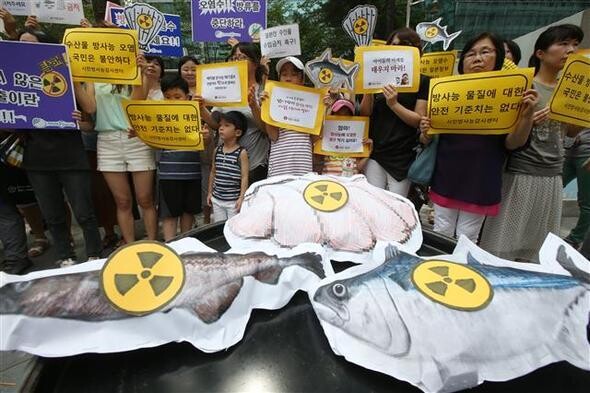hankyoreh
Links to other country sites 다른 나라 사이트 링크
Study finds 5.3% of domestic and Russian seafood contains radioactive material

Radioactive material was discovered at detectable levels in domestic and Russian seafood products, a recent study confirms.
The news comes amid growing concerns about radiation contamination in seafood products entering the country since the 2011 disaster at Japan’s Fukushima I Nuclear Power Plant. In response, environmental groups are calling for more intensive inspections of seafood for radioactivity.
The findings were announced on Dec. 23 after a study by three groups: the Institute for Environment & Community Development Studies (IECDS), the Korea Radiation Watch Center, and the Gwangju chapter of the Korean Federation for Environmental Movement. Analysis of 150 samples of mackerel, pollock, cod, kelp, and sea mustard taken from discount stores and markets in Seoul, Busan, and Gwangju between March and November showed the presence of radioactive cesium-137 in eight of them, or 5.3%.
Cesium-137 is considered one of the chief examples of a radioactive isotope detected in the process of artificial nuclear fission, with an acceptable standard of 100 becquerels per kilogram.
The isotope was found in samples of pollock and cod from Russia and domestic mackerel and kelp at levels of 0.37 to 1.09 becquerels per kilogram.
The highest rate of detection was for Russian cod at 13%, followed by Russian pollock at 11.5%, Korean kelp at 7.7%, and Korean mackerel at 3.3%.
By place of origin, Russian products showed the highest detection rate at 13.3% (six out of 45 samples), compared to a 3.2% rate for domestic products (two out of 63 samples). No radioactive material was found in other imported seafood.
The overall Ce-137 detection rate for domestic and imported seafood was down slightly from a similar survey conducted last year, falling from 6.7% to 5.3%. But the rate for Russian products showed a slight increase from 13% last year to 13.3% in 2015.
“The radioactive material detection rate for Russian products was quite high. We need greater monitoring and more stringent standards,” said IECDS researcher Min Eun-ju.
“We also need to figure out the cause behind the radioactive material detected in Korean sea grasses and take appropriate steps,” Min added.
Min also weighed in on the South Korean government’s current plans to consider lifting import bans on seafood from eight Japanese prefectures.
“If that happens, there will be no way to stop the import of seafood contaminated with radioactivity. We should be beefing up our standards, not loosening them, and we should be responding forcefully to the Japanese government’s complaint with the World Trade Organization,” she said.
Ce-137 has a half-life of over thirty years and is known to cause radiation exposure within the body as it accumulates in muscles and subcutaneous fat. The details of its effects on the human body from exposure through accumulation of small amounts remain unknown.
By Kim Young-dong, staff reporter
Please direct questions or comments to [english@hani.co.kr]

Editorial・opinion
![[Editorial] Does Yoon think the Korean public is wrong? [Editorial] Does Yoon think the Korean public is wrong?](https://flexible.img.hani.co.kr/flexible/normal/500/300/imgdb/original/2024/0417/8517133419684774.jpg) [Editorial] Does Yoon think the Korean public is wrong?
[Editorial] Does Yoon think the Korean public is wrong?![[Editorial] As it bolsters its alliance with US, Japan must be accountable for past [Editorial] As it bolsters its alliance with US, Japan must be accountable for past](https://flexible.img.hani.co.kr/flexible/normal/500/300/imgdb/original/2024/0417/6817133413968321.jpg) [Editorial] As it bolsters its alliance with US, Japan must be accountable for past
[Editorial] As it bolsters its alliance with US, Japan must be accountable for past- [Guest essay] Amending the Constitution is Yoon’s key to leaving office in public’s good graces
- [Editorial] 10 years on, lessons of Sewol tragedy must never be forgotten
- [Column] A death blow to Korea’s prosecutor politics
- [Correspondent’s column] The US and the end of Japanese pacifism
- [Guest essay] How Korea turned its trainee doctors into monsters
- [Guest essay] As someone who helped forge Seoul-Moscow ties, their status today troubles me
- [Editorial] Koreans sent a loud and clear message to Yoon
- [Column] In Korea’s midterm elections, it’s time for accountability
Most viewed articles
- 1[Column] The clock is ticking for Korea’s first lady
- 2Samsung barricades office as unionized workers strike for better conditions
- 3[Editorial] When the choice is kids or career, Korea will never overcome birth rate woes
- 4[News analysis] After elections, prosecutorial reform will likely make legislative agenda
- 5S. Korea, Japan reaffirm commitment to strengthening trilateral ties with US
- 6Why Israel isn’t hitting Iran with immediate retaliation
- 7[Guest essay] How Korea turned its trainee doctors into monsters
- 8Japan officially says compensation of Korean forced laborers isn’t its responsibility
- 9[Editorial] Does Yoon think the Korean public is wrong?
- 10[Editorial] 10 years on, lessons of Sewol tragedy must never be forgotten